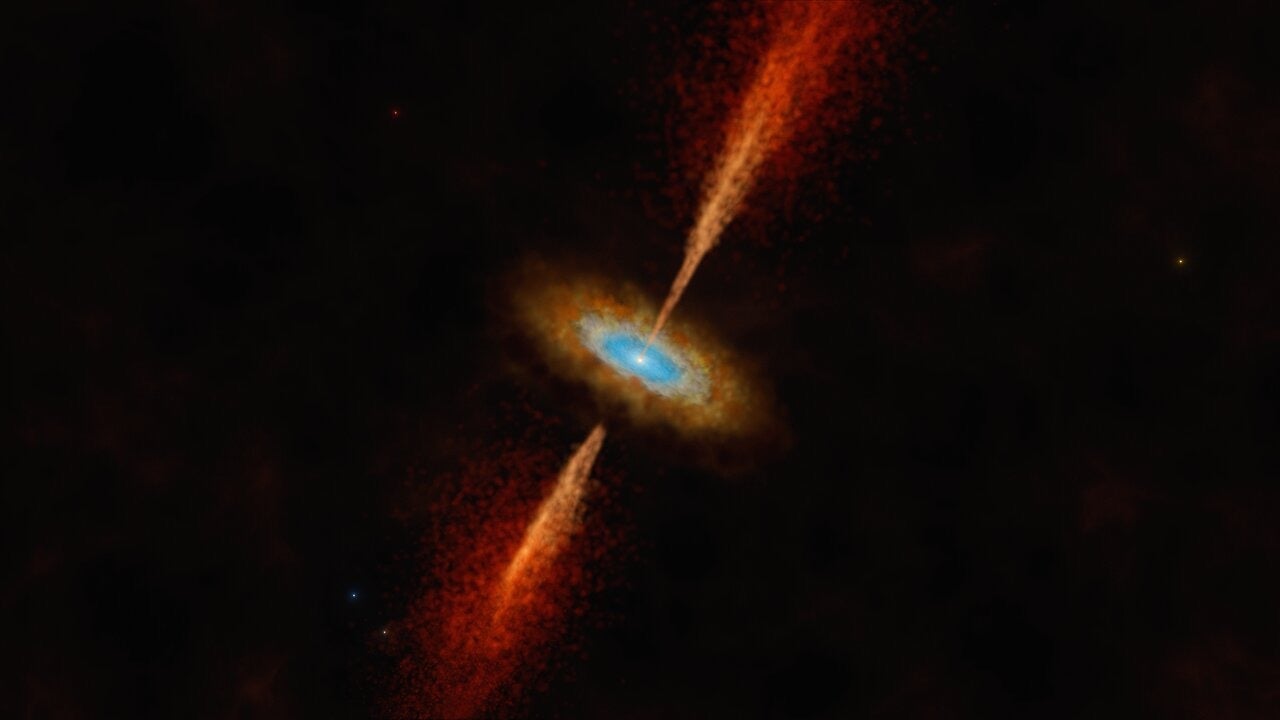Published: November 29, 2023John WenzAstronomers discover disk around star in another galaxy
An artist’s impression of the disc and jet in the young star system HH 1177. Credit: The European Southern Observatory (ESO)
Astronomers using the Atacama Large Millimeter/submillimeter Array (ALMA) in the Chilean desert have just achieved an impressive astronomical first: Imaging a planet-forming disk around a star in another galaxy.
The results of their efforts were published Wednesday in a paper in Nature. The discovery will now allow astronomers to watch as the star, HH 1177, undergoes the process of planet formation. It will also allow astronomers to compare the formation of planets, including the types of material available to form them, between stars in the Milky Way and those in HH 1177’s home galaxy, the Large Magellanic Cloud (LMC).
Far from home
The LMC is a satellite galaxy of the Milky Way, located about 160,000 light years away. It’s a much smaller galaxy than our own, with only around 10 percent the amount of stars. It’s the largest of our satellite galaxies and is slowly being pulled toward our own galaxy.
Just as other stars have different chemical compositions than the Sun, different galaxies have different chemical compositions than the Milky Way, with different ratios of available “ingredients.” The LMC in particular has lower metal content (astronomers call all elements heavier than helium “metals”) and less dust than our own galaxy, according to study lead author Anna McLeod, an astrophysicist at Durham University in the UK.
Lower metal content may have been a boon in finding the circumstellar disk around HH 1177, she says. “The lower metal content leads to higher stellar and gas temperatures, and the combination with the lower dust content resulted in the star being visible in the optical,” McLeod says. “Usually, these types of stars are deeply embedded in their natal material, hidden from sight,” McLeod says. “But because it has formed in an environment that is different from that of the Milky Way, it is not embedded and we can see it” with optical telescopes, which observe at the same wavelength as the human eye sees.
Hints of a disk
But the astronomers behind the paper didn’t just stumble on the disk. They had some hints it was there. In a 2018 Nature paper, they reported evidence of a massive jet coming from the star and interacting with the surrounding interstellar material. This kind of jet is typically only seen in very young stars undergoing planet formation.
“From the presence of the jet we deduced the presence of a disk,” McLeod says, as such jets are often signposts of accretion onto a disk. So, the team submitted a proposal to look for such a disk using ALMA after their initial paper was published. That’s because even though the star is visible at optical wavelengths, the dusty disk surrounding it is better rendered at the longer radio wavelengths probed by ALMA.
And using ALMA they saw exactly what they were looking for. “We now have direct detection of [the disk],” she says.
A huge find
HH 1177 is about 15 times the mass of the Sun, the type of star that leads a short, explosive life ending in a fiery supernova. The disk itself could be up to 12,000 astronomical units across, where 1 astronomical unit, or AU, is the average Earth-Sun distance of 93 million miles (150,000 kilometers).
The find around HH 1177 represents an exciting opportunity for astronomers to study the circumstellar disk from which planets may ultimately form in a star system far from home. McLeod now hopes to look at the star with the James Webb Space Telescope, whose infrared vision could reveal even more stunning details there. Additionally, she says, high-quality data in infrared wavelengths would better constrain the properties of both the star and its disk.
“We are in an era of rapid technological advancement when it comes to astronomical facilities,” she said in a press release about with the find. “Being able to study how stars form at such incredible distances and in a different galaxy is very exciting.”





